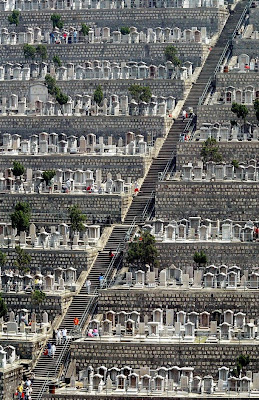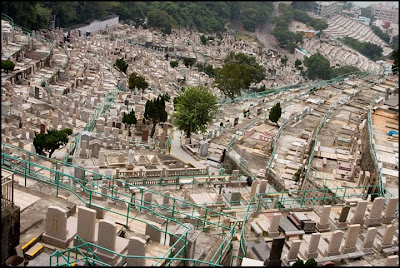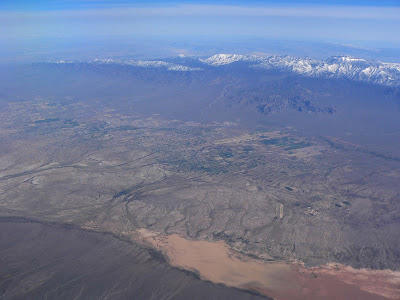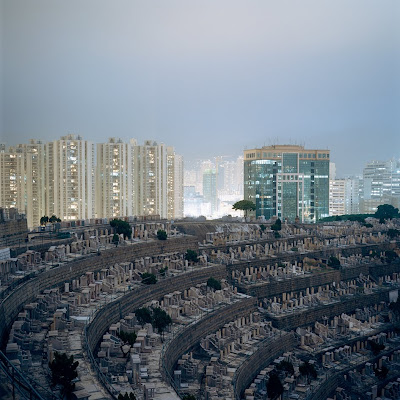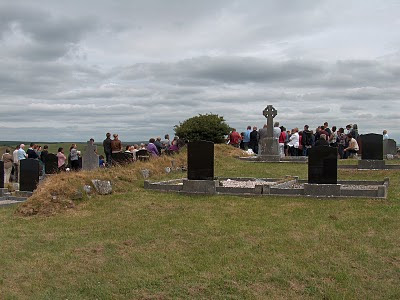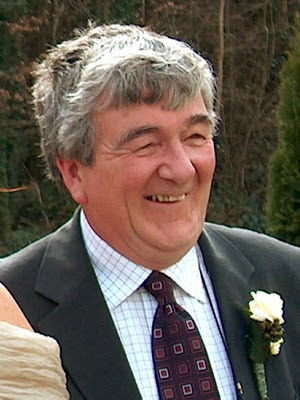There is perhaps no more important place for the arts to have an impact than at cemeteries. Creative designs based on a deep understanding of the needs of the grieving and the stories of the departed make an enormous difference in the lasting impact and relevance of a cemetery. In order to be relevant to their families and communities, cemeteries need to create spaces and memorials designed to appeal to families, not to groundskeepers. In this series, "Making Cemeteries Relevant" I highlight the work of cemetery innovators. I am very pleased to present in this installment, the moving work of landscape architects, Lees + Associates, and to share a conversation with Erik Lees.
Pat McNally: When most people think of cemetery projects, they often envision something cold and formal. Something you may need, but wouldn’t necessarily get excited about. Your work is different. In the nature of the projects your firm has been involved in, and the responsiveness of your designs to the stories behind the grounds, and the people who will visit there, I find something very compelling.
What is it about your approach to a project that results in the very personal and human quality of the end result?
Erik Lees: Our approach is collaborative. I think that is one of the reasons the cemeteries we design have a unique character and feel. Working closely with cemetery managers, sales and field workers means that we are able to capture the “site intelligence” that our firm alone could never acquire. We also strive for meaningfulness in our work, in fact it is a common refrain around our office. This means not only a direct relationship with the unique physical qualities of the cemetery, but a thorough understanding of the community, demographics and their interment and memorialization preferences and patterns.
PM: Your firm has been involved in many very interesting and prestigious projects. In our time here, I’d like to specifically discuss four: The Royal Oak Green Burial Area, The Woodlands Memorial Garden, the Doukhobor Commemorative Site, and the Mountain View Cemetery Masonic Area Redevelopment. Each of these projects presented unique challenges, to which creative, humane responses were made.
Let’s start with the green burial area at Royal Oak. Often the idea of a green cemetery is one where a parcel of land is left to natural forces to determine what changes are made to the landscape. Often the reality, at least in the UK where the green burial movement has had its biggest impact, is an unattractive and chaotic row upon row of memorial plantings. While the deceased may have wished to have no permanent marker, survivors often feel differently. The approach at Royal Oak is different, combining a planned layout with green values. Please tell us about your approach and design parameters for this project.
EL: We had three primary objectives when Stephen Olson (Royal Oak Burial Park Manager) asked us to work with him on the Green Burial Area: optimize space utilization, maximize habitat value and create a rich, meaningful experience for those that choose green burial. Our approach is that green burial should not consume more land than traditional burial, so we platted the site at a density roughly equivalent to the rest of the cemetery. In this way the yield in terms of the # of graves per acre was optimized and the financial returns for the cemetery were approximately the same as for traditional burial. Each grave is planted with native shrubs and ground covers and certain graves also accommodate a native tree. This approach will see the habitat value of the green burial area meet or exceed that of the adjacent natural west coast forest. It will also create a feeling that is unique to this part of the world – further enhancing the meaning to this space. One of the challenges with green burial is the manner and method of memorialization. At Royal Oak we created a series of 9 communal memorial stones in basalt where the names of those interred will be inscribed. Basalt is native to British Columbia, takes a beautiful inscription and fits very well with the native plantings. This combination of materials creates a sense of place that few other cemeteries enjoy.
PM: I was deeply moved by your work at Woodlands Memorial Garden. People who are developmentally disabled have historically been so marginalized, that there is a great satisfaction in seeing this kind of memoriaization, albeit long after the deaths of many of the commemorated residents of this facility. The integration of the old markers is particularly telling and moving. What challenges and inspirations did you find in this project?
EL: There were so many challenges with this project, but great projects are rarely simple!
The headstones from this 2 acre cemetery had been removed over 40 years ago, some of which were just dumped in a ravine, some were used for patio stones and a retaining wall – as sacrilegious as this may seem. Our task was to repatriate those stones to the cemetery site, but in the absence of accurate records, we were not able to definitively say where each headstone belonged, hence our decision to incorporate them in to a series of walls. The other challenge was that we only found 900 of the 3200 headstones, so we had to devise a system to acknowledge and remember all those that were buried there, not just those whose names were on the headstones we found. As with all our projects we undertook thorough research and during that process found inspiration in the history of the institution and even more so: the stories of those who lived there.
One of the most compelling stories was how many of the children were housed in dormitories with windows too high to see out of. We decided to create a “window too high” and although it is far more literal than we might otherwise choose, it proved to be a very powerful icon in the garden and one around which visitors had their picture taken.
PM: The Doukhobor Commemorative Site is a site that marks a tragic period of separation, rather than the physical resting place of the families it memorializes. In this site you were able to communicate the story of a community torn apart to those intimately familiar with it, and to those who have never heard of it in a compelling and sensitive manner. It seems to me that you were also very responsive to the cultural touchstones of the Doukhobor community in this process. Please give a bit of background on the story, and tell us how this project was envisioned and completed.

EL: I was drawn to this project after spending much of my early adult years in the West Kootenay area of British Columbia. This is where the Doukhobour community settled after a long period of exile and immigration from Russia and forced movement across Canada. A breakaway sect of the Doukhobours, called the Sons of Freedom, undertook varying degrees of civil disobedience in the early 1950’s. In response, the Government of BC chose to house the sons and daughters of the Sons of Freedom in New Denver – a remote mountainous community that in those days was far removed from the communities in which their parents lived. Over a 5 year period hundreds of children were housed and schooled in a facility in New Denver.
Our task as designers was to create commemoration that told the story in a fair and objective manner, but also reflected the heart wrenching and long lasting effects of the event. Given their communal lifestyle and importance of sharing bread, salt and water at community tables, we created a long community table that was “broken.” The seats around the table are smaller at one end and larger at the other. The plan also included large local stones upon which the first person narratives were to be inscribed. Unfortunately, and perhaps tellingly, this part of the design was never implemented.
PM: Mountain View Cemetery one of the most progressive and culturally responsive cemeteries in North America. In the past, I have interviewed Cemetery Manager Glen Hodges and Artist in Residence, Paula Jardine. Now I have a new connection to Mountain View in you! Mountain View is a cemetery that had run out of burial spaces, and as a result had lost it’s source of income and connection to the community of Vancouver. What has been accomplished there is nothing less than remarkable, and your firm has been an important part of it. The Masonic Area Redevelopment was the first of the cemetery’s 12 sections to be redeveloped, and in addition to creating more and varied interment options there, your firm created some remarkably attractive and inviting areas for people to spend time. The beauty and scale of a cemetery section is vitally important because when families feel comfortable and inspired when visiting, they will return again and again. This attachment to place is a great benefit to the survivor in continuing their relationship with the deceased, for the community, in having a sense of ownership in the cemetery, and for the financial future of the cemetery itself.
What thoughts and concerns went into the creation of this project?
EL: You are correct in that Glen Hodges and Paula Jardine have been two of many keystones to the success of the re-development of Mountain View. Our role was to lead a group of design, heritage and financial consultants in creating the re-development plan, in collaboration with Glen. One of our primary concerns was to develop a design that was not just sympathetic to the very historic Masonic Area, but to enhance it in a sensitive, yet modern way.
We approached this through two primary routes. First we were very careful to integrate the design of the columbaria, family vessels and commemorative elements with the proposed new customer service building and celebration hall. We worked closely with Sandra Moore, Architect, on the landscape around the building and she worked closely with us on the improvements in the Masonic Area. The second strategy we used was to choose materials that worked beautifully with the grey granite curbs and headstones in the area. We took a disciplined, deliberate approach to the selection of material types, colours and textures which resulted in an elegant palette of granite, basalt, concrete and andesite. Cast and extruded aluminum further integrated the cemetery re-development with the buildings.
.
We also wanted to be sure the columbaria were specific to Mountain View, and so we designed a “rosette-less” system that is at once secure, convenient for field staff and beautiful. It also allowed us to optimize the number of interment options we were able to accommodate on the very narrow and limited road and pathways in this part of the cemetery. Collaboration with Glen and his team, combined with sensitivity to the site has led to a very meaningful and beautiful place.
PM: Thank you for your time, Erik, and thank you for the remarkable projects your firm has created. These memorials have inspired me and I hope that they will inspire other cemeteries and firms to be more creative and responsive in their work. I invite my readers to visit Lees + Associates on the web to view more of their projects.
For more of the articles in this series, visit:
